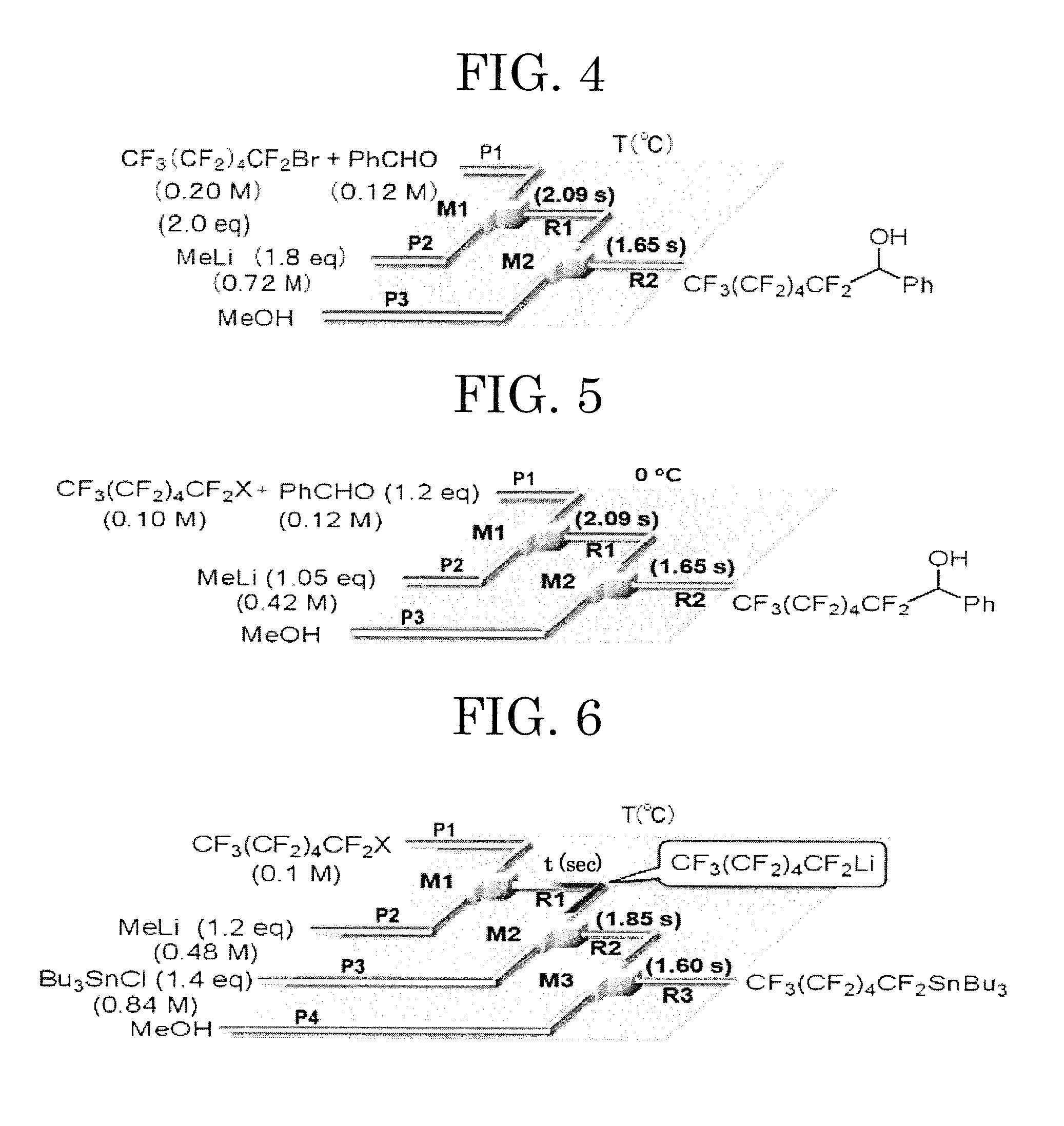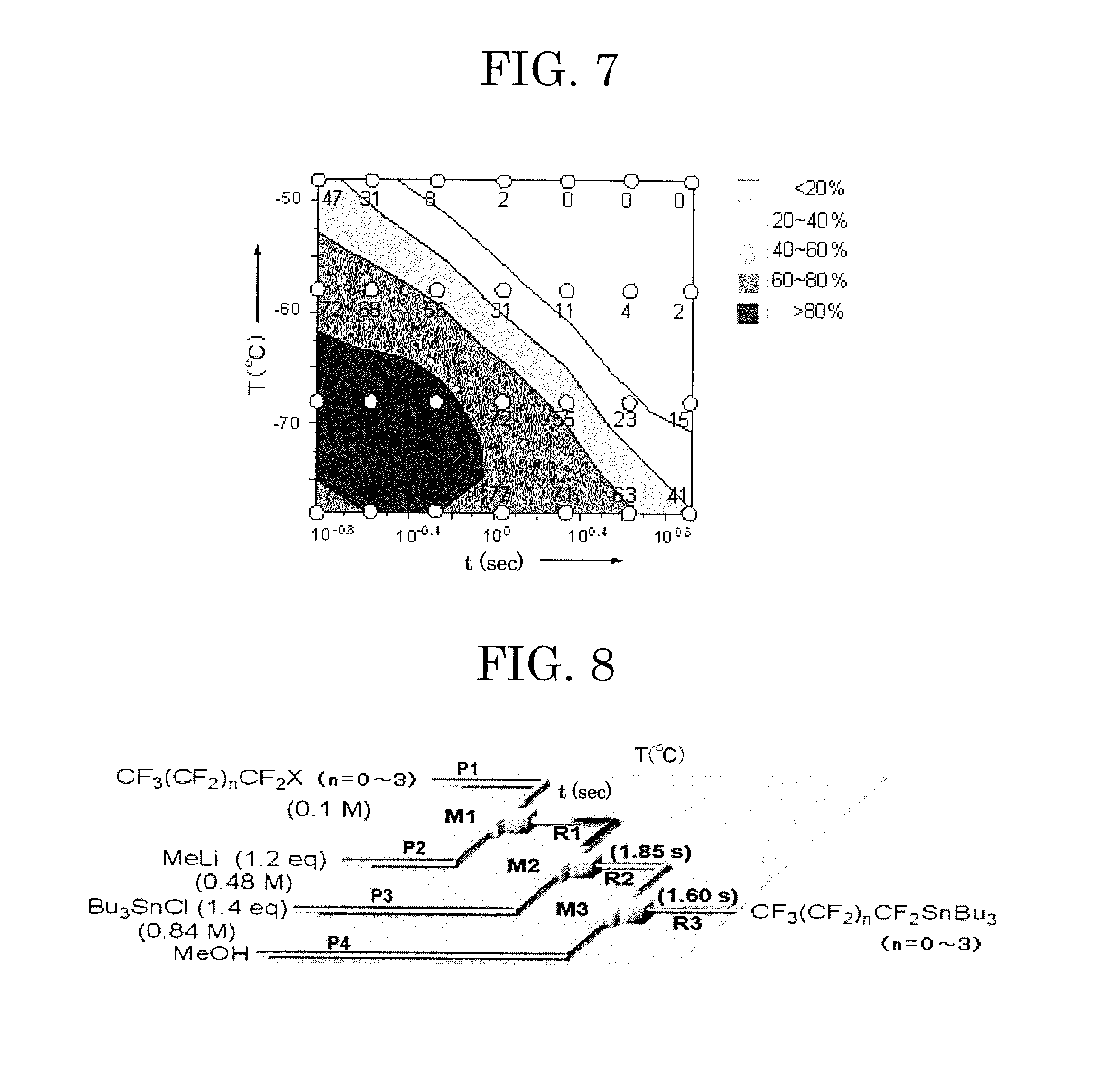Method for Producing Fluorine-Containing Substituted Compound and Fluorine-Containing Substituted Compound
a technology of substituted compounds and substituted compounds, which is applied in the preparation of carbonyl compounds, organic chemistry, and group 5/15 element organic compounds, etc., can solve the problems of inability to use fluorine-substituted lithiumcarbenoid species for synthesis reaction, extreme instability, and unstable fluorine-substituted lithiumcarbenoid species
- Summary
- Abstract
- Description
- Claims
- Application Information
AI Technical Summary
Benefits of technology
Problems solved by technology
Method used
Image
Examples
example 1
[0224]The microreactor used in present Example is constituted so as to include micromixers composed of a T-shaped tube fitting, and tube reactors connected downstream of the micromixers respectively (see FIG. 4).
—Micromixers—
[0225]As the micromixers (in FIG. 4, denoted by “M1” and “M2”), custom-made products manufactured by Sankoh Seiki Kogyo Co., Ltd. were used (it is possible to obtain equivalents by requesting the production on the basis of the description in present Example). The micromixers used in present Example each have inside thereof a first introduction path, a second introduction path and a portion of the flow path with which these introduction paths are merged, and the inner diameters of these introduction paths are the same as each other inside the micromixer. Accordingly, hereinafter, these inner diameters are collectively referred to as “the inner diameter of the micromixer.”
—Tube Reactors—
[0226]As the tube reactors (in FIG. 4, denoted by “R1” and “R2”), stainless st...
example 11
—Microreactor—
[0240]The microreactor used in Example 11 is constituted so as to include micromixers composed of a T-shaped tube fitting, and tube reactors connected downstream of the micromixers respectively (see FIG. 5). The same micromixers and the same tube reactors as in Example 1 were used.
[0241]By diluting CF3CF2I (iodopentafluoroethane, manufactured by Aldrich Corp.) and benzaldehyde with diethyl ether (Et2O), a mixed solution of CF3CF2I and benzaldehyde having the concentrations of 0.10 M and 0.12 M, respectively, was prepared. By diluting diethyl ether (Et2O), a 0.12 M solution was prepared. By diluting methyllithium (MeLi) with diethyl ether (Et2O), a 0.42 M methyllithium solution was prepared.
[0242]The prepared mixed solution of CF3CF2I and benzaldehyde was introduced from one inlet of the microreactor M1, and the prepared methyllithium solution was introduced from the other inlet of the microreactor. The solutions were each sucked into a gas-tight syringe, and then liqui...
examples 12 to 22
[0252]In each of Examples 12 to 22, the fluorine-containing substituted compound was produced and the yield thereof was measured in the same manner as in Example 11 except that in Example 11, CF3CF2I (iodopentafluoroethane) as the organofluorine compound and benzaldehyde as the electrophile were altered to the components shown in Table 1. The results thus obtained are shown in Table 4.
TABLE 4Fluorine-containingCF3(CF2)nCF2XElectrophilesubstituted compoundYield (%)Ex. 11CF3CF2I84Ex. 12CF3CF2CF2I80Ex. 13CF3(CF2)2CF2I85Ex. 14CF3(CF2)3CF2I86Ex. 15CF3(CF2)4CF2I80Ex. 16CF3(CF2)4CF2Br71Ex. 17CF3(CF2)4CF2I70Ex. 18CF3(CF2)4CF2I42Ex. 19CF3(CF2)4CF2I79Ex. 20CF3(CF2)4CF2I86Ex. 21CF3(CF2)4CF2IMe3SiOTfC6F13SiMe330Ex. 22CF3(CF2)4CF2IBu3SnClC6F13SnBu3 2
[0253]In Table 4, X represents an iodine atom or a bromine atom, Me represents a methyl group, Bu represents an n-butyl group, Ph represents a phenyl group, and Tf represents a trifluoromethylsulfonyl group.
[0254]From the results of Examples 11 to 22...
PUM
| Property | Measurement | Unit |
|---|---|---|
| temperature | aaaaa | aaaaa |
| temperature | aaaaa | aaaaa |
| temperature | aaaaa | aaaaa |
Abstract
Description
Claims
Application Information
 Login to view more
Login to view more - R&D Engineer
- R&D Manager
- IP Professional
- Industry Leading Data Capabilities
- Powerful AI technology
- Patent DNA Extraction
Browse by: Latest US Patents, China's latest patents, Technical Efficacy Thesaurus, Application Domain, Technology Topic.
© 2024 PatSnap. All rights reserved.Legal|Privacy policy|Modern Slavery Act Transparency Statement|Sitemap



